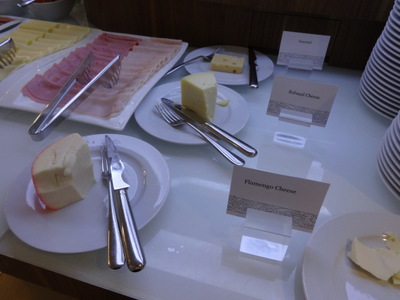
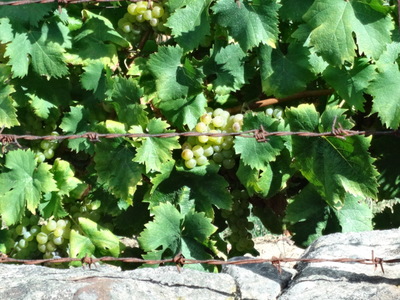 During dinner the evening before, the Hemming had recrossed the river and moored back at Barca d'Alva. Friday morning, even before breakfast, it cast off to head back downstream to Pochino.
During dinner the evening before, the Hemming had recrossed the river and moored back at Barca d'Alva. Friday morning, even before breakfast, it cast off to head back downstream to Pochino. Friday, 28 August 2015: Bread and Wine in Favaios
Written 16 May 2016

 During dinner the evening before, the Hemming had recrossed the river and moored back at Barca d'Alva. Friday morning, even before breakfast, it cast off to head back downstream to Pochino.
During dinner the evening before, the Hemming had recrossed the river and moored back at Barca d'Alva. Friday morning, even before breakfast, it cast off to head back downstream to Pochino.
At the left here is that morning's assortment of breakfast cheeses. In the forground is "Flamengo," behind it is "Rabaçal (my favorite among the Portuguese cheeses), and behind that is "Emmenthal" (presumably not a product of Portugal).
Pochino has 250 inhabitants. It's currently the last stop of the railroad from Porto. The rest of the line was inactivated in 1989, three years after the open-borders treaty took effect. To Viking staff, it is where unhappy crew members are dropped off to take the train back to Porto. We got there about 8:45 a.m., to find our buses waiting, and we all set off by bus, at 9:15 a.m., to visit the "bread and wine" village of Favaios. About five minutes later, as our buses climbed up into the mountains, the Hemming cast off again, heading for Pinhão, where we would rendezvous with it for cocktails and dinner. Up to this point, most of what we've learned about this area's wines has focused on port, but now the emphasis shifted to muscatel.
In the 1930s, new rules abruptly went into effect that said no port could be made with grapes grown above above 500 m altitude, and Favaios was 130 m too high. At a stroke, its sole source of income and trade was wiped out, and the village was plunged into a years-long recession. In 1950, coops were promoted, and in 1952, Favaios reinvented itself as the village of bread and wine. It formed a coop to produce muscatel wine from muscat grapes, a white gallicean variety (shown at the right above). Originally the coop had 100 members, from six founding familes. Now it has 500 members and includes virtually everyone. (The village only has 1500 inhabitants, including men, women, and children.) Five traditional bakeries produce the famous "four-cornered" loaves of bread, a thousand a day from each bakery. Three additional, nontraditional bakeries mass produce more. The bread is sometimes shipped as far as Porto and Lisbon, because it stays fresh for four days, but no more. Finally the village produces a traditional jam from melons and some cheese.
Accordingly, we were scheduled to see three venues in the village: a bakery, the bread and wine museum, and a winery. Our bus did them in that order, and the other two buses started elsewhere so that we could all rotate through all three.
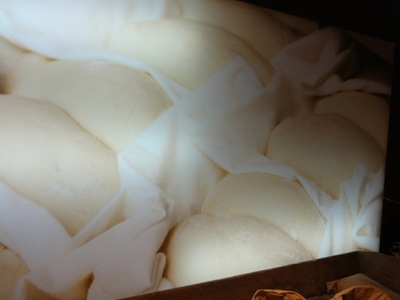
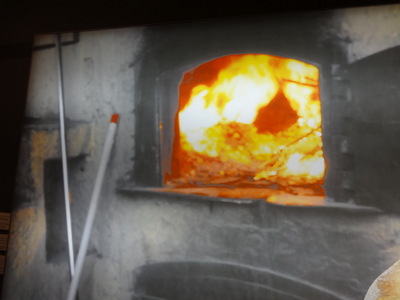 These two photos weren't actually taken at the bakery—they're actually pictures of pictures I found in the bread and wine museum—but they serve as a good introduction.
These two photos weren't actually taken at the bakery—they're actually pictures of pictures I found in the bread and wine museum—but they serve as a good introduction.
At the left, you can see the famous "four-corners" bread in the rising-dough phase. A sheet of floured canvas is folded up to form little "nests" in each of which two ovals of dough are nestled. During rising and baking, they two merge at the point where they touch, forming the bread's characteristic shape.
The right-hand image shows the wood-fired oven being preheated—it's packed full of wood (choice of wood species is one of the variables differentiating the towns five artisanal bakeries; the one we visited uses pine exclusively, and they also have their own proprietary water source, separate from the city supply), which is burned down to coals, then raked out. The brick and stone walls of the oven hold the heat, and several batches of bread can be baked in it in succession before it's reheated.

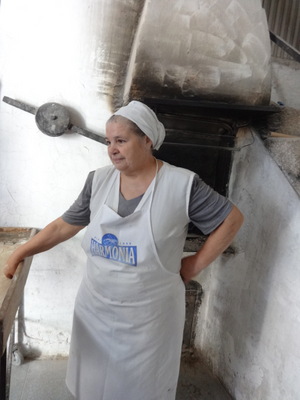 We were met at the door of the actual bakery by an accordionist, who accompanied us throughout the visit, serenading us with traditional music.
We were met at the door of the actual bakery by an accordionist, who accompanied us throughout the visit, serenading us with traditional music.
The photo at the right is the master baker herself, the very one who appears in the Viking TV ads.
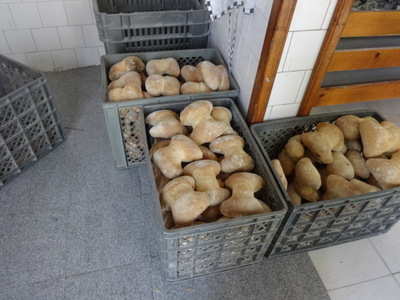
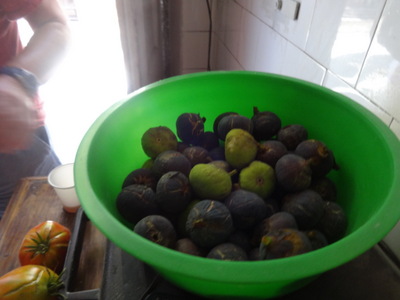 As the bread is pulled out of the oven, it's piled on the wooden table you can see in the photo. A larger table, behind us when the photo was taken, was set with tubs of butter and bowls of melon jam (made, I think, with the large white melons we'd been eating throughout the cruise). Loaves were pulled from the oven and dumped on the table, still almost too hot to touch, and we got to pull them apart and sample them on the spot. Yummy!
As the bread is pulled out of the oven, it's piled on the wooden table you can see in the photo. A larger table, behind us when the photo was taken, was set with tubs of butter and bowls of melon jam (made, I think, with the large white melons we'd been eating throughout the cruise). Loaves were pulled from the oven and dumped on the table, still almost too hot to touch, and we got to pull them apart and sample them on the spot. Yummy!
On a shelf to one side, I spotted this bowl of figs and a couple of tomatoes from the bakery's garden.
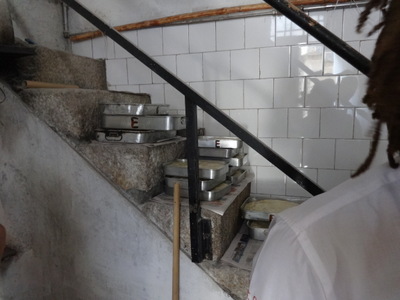

The bread consists of only the traditional four ingredients: flour, water, yeast, and salt. They use yeast and not sourdough or a starter from the previous batch. The dough spends an hour in the mixer, then rises for 20 minutes before shaping. After another 20-minute rising period, It goes into the oven. Each oven holds 120 loaves at a time. The bakers start work at 3 a.m., take a rest at 2 p.m., then come in again later to get ready for next day.
On the steps of the open stairway (just behind the baker, shown above) a couple of dozen wide flat metal baking pans were stacked, awaiting their turn in the oven. These are "bolo," or meat cakes. People bring the meat filling they want to the bakery, and for a fee, the bakers line the pan with dough, add the filling, cover it with more dough, and bake it. Ths customers then drop by later to pick up the finished product to take home to dinner.
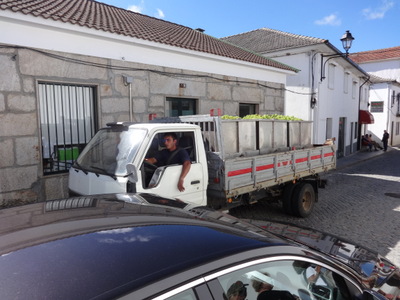
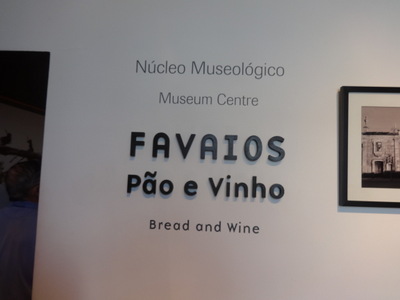 From the bakery, we had a 5-10 min walk to the bread and wine museum, and on the way, much to the excitement of our dread-locked city guide, Mitum (pronounced "me-too"), his trainee Patricia, and the Viking staff, the very first trucks of the season passed us, filled to overflowing with muscat grapes, on the way to the crusher at the coop! From the bus coming into town, we had seen some people in the fields who seemed to be picking grapes, but we couldn't be sure they weren't just testing for ripeness; normally, the grapes wouldn't have been ready for another week or two.
From the bakery, we had a 5-10 min walk to the bread and wine museum, and on the way, much to the excitement of our dread-locked city guide, Mitum (pronounced "me-too"), his trainee Patricia, and the Viking staff, the very first trucks of the season passed us, filled to overflowing with muscat grapes, on the way to the crusher at the coop! From the bus coming into town, we had seen some people in the fields who seemed to be picking grapes, but we couldn't be sure they weren't just testing for ripeness; normally, the grapes wouldn't have been ready for another week or two.
Along the way, Mitum gave us some statistics. The village is on a 1000-ha plateau at 600 m altitude. Its 500 inhabitants produce 3 million bottles of wine per year, but 25 million of those are miniatures. Most of the wine production (and all of the 8,000 loaves a day of bread) is consumed in the Portuguese market.
We learned that Salazar segregated the schools, so the school still has separate classrooms, but the kids have been remixed. We paused on the way to watch a charming video that the children (maybe 20 of them) had made to welcome tourists and to show their pride in their village. We were introduced to the oldest man in Favios, 105 years old, who says his secret is drinking lots of muscatel. We walked past a house with "1782" carved over the door. The guides pointed out the Santa Barbara chapel, perched at the highest point above the village. When bad weather threatens, someone climbs up early in the morning and rings its bell to head off the storm; sometimes it works.
We even peeked into the local barber shop. The barber charges 5 euros to cut your hair, but (we were told) 7 if you're bald—if he has to search for the hair it takes him longer. A nearby three-story house is for sale in the middle of the village and has been for quite a while. The owners asked 50,000 euros for it until Viking started to come three years ago; now they're asking 200,000 euros. People make fun of them, but I think they've got the right idea—some Viking passenger is bound to fall for the place sooner or later.
The museum was very informative but not very photogenic. It consists mainly of images and text, although the sniffing gallery of the flavors of muscotel was fun, and it features a gigantic fiberglas four-corners bread over the door. Many of the walls are decorated with wine- and bread-relevant quotations, like "bread by its colour and wine by its taste," "eat wheat in May and drink wine in August," "Men are like wine, some turn to vinegar but the best improve with age" (Cicero), and "Penicillin cures but wine makes people happy" (Fleming).
Things we learned:
Outside the museum, one member of our group who was using a wheelchair that day dropped a wheel into a curb-cut in the sidewalk (intended, ironically, to make wheelchair access) and took a spill onto the cobblestones! She pooh-poohed the problem, saying it happens all the time, but ouch—it didn't look like fun!
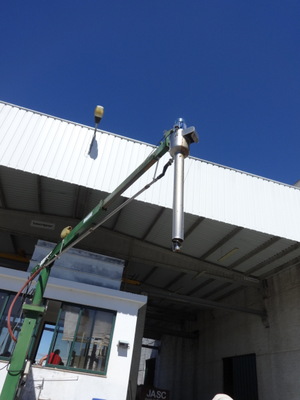
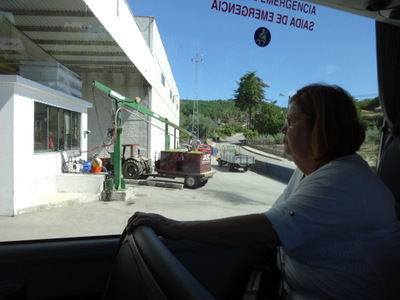 From the museum, we boarded the bus for the ride to the wine coop, where Joao, our second city guide, took over. The place was a little hectic, because they literally started the harvest that day, sooner than expected. Trucks were pulling in as we arrived.
From the museum, we boarded the bus for the ride to the wine coop, where Joao, our second city guide, took over. The place was a little hectic, because they literally started the harvest that day, sooner than expected. Trucks were pulling in as we arrived.
At the entrance to the winery was this amazing apparatus, shown in the ready position at the left and being deployed in the right-hand photo. It's long nose, perhaps six inches in diameter, was plunged into the middle of each truckload of grapes. An Archimedes screw inside the cylinder turned, lifting grapes up the shaft, crushing them, and spewing them out the top and back into the truck. Within 30 seconds, the average sugar content of the juice appeared on a digital read-out in the glass-walled booth. If the sugar was too low, the whole truckload was rejected. Several trucks were tested during our visit, and all were suitably sugary. They aim for 12.5% alcohol, which requires 210 grams of sugar per liter of juice (maybe 1 part sugar and four 4 parts liquid; that's sweet!).
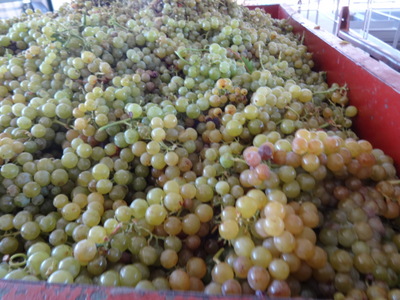
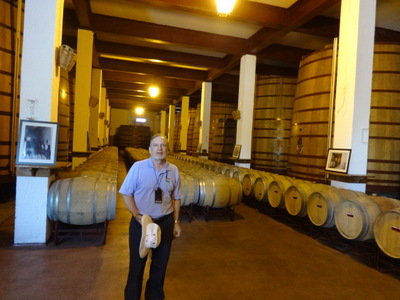 Each truck that passed the test then pulled forward into the covered area where the grapes were dumped into the crusher. As a truck pulled in while we were standing there, our guide asked permission, then stepped up on the running board, pulled down a large heavy cluster of grapes, and passed them around, so that we could all taste. They were still warm from the sun and very soft, sweet, and juicy. The seeds were large, but the skins were tender enough to eat. Yum!
Each truck that passed the test then pulled forward into the covered area where the grapes were dumped into the crusher. As a truck pulled in while we were standing there, our guide asked permission, then stepped up on the running board, pulled down a large heavy cluster of grapes, and passed them around, so that we could all taste. They were still warm from the sun and very soft, sweet, and juicy. The seeds were large, but the skins were tender enough to eat. Yum!
A crane over the crusher swung over to lift each bin off the back of the truck and upend it over the giant hopper. Muscat grapes are destemmed but only lightly crushed before fermentation begins, rather than truly pressed. We've seen video footage and hundreds of photos, but this was the first time we'd ever seen the grapes delivered to the winery in person.
At the right is a photo of David in one of the tank and barrel rooms. Outdoors, we saw huge hemispherical cement tanks, some holding 1/2 million liters and some only 1/4 million. They're called "Ginas" for Gina Lolobrigida. If you observe two of them side by side, you can see why. Some wine makers claim that stainless steel is not as good as concrete for wine storage.
They start fermentation at 16°C. The Portuguese claim the original foot-treading process served to raise the temperature of the grapes to this level to trigger fermentation), but now each tank can be either heated or cooled with water jackets, to keep the temperature between 15 and 20°C. The juice is macerated with the skins, which are mixed back into the wine to extract more flavors. Fermentation is stopped at 190 g sugar per liter. In a couple of days, you get about 2% alcohol and down to 90 g sugar. Fermentation is always stopped at the end of the third day, by addition of almost 1 part 77% wine spirits to 3 parts wine. That runs the alcohol up to 17%. Then the wine is aged at least 2.5 years, and up to 3 years, to balance the sugar and the aromas.
The aging barrels are made of French, American, and Portuguese oak and Chestnut. I asked which species of American oak; no one was sure, but maybe white oak. During aging, French oak adds spicy flavors, Portuguese chocolate and dried fruit, and American a whole lot of flavors, starting with vanilla. A hundred-year old muscstel is almost black. The oldest this coop has is 1956, and only a little is left.
French oak is spicy; Portuguese is chocolate and dried fruit; American a whole lot of flavors, starting with vanilla. A hundred-year-old muscatel is almost black. The oldest this coop has is 1956, and only a little is left.Written 3 June 2016
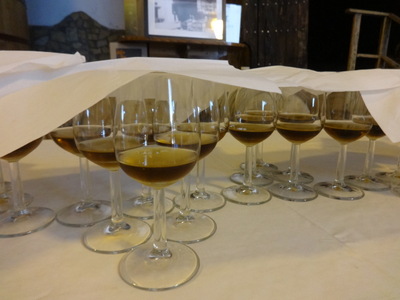
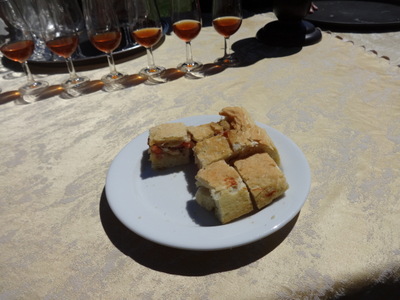 As usual, the visit ended with a tasting. We were told to sniff for orange, apricot, and some other flavor I've forgotten. As usual, the wine was entirely wasted on me—I tasted David's, and it was sweet, but not sweet enough in my opinion.
As usual, the visit ended with a tasting. We were told to sniff for orange, apricot, and some other flavor I've forgotten. As usual, the wine was entirely wasted on me—I tasted David's, and it was sweet, but not sweet enough in my opinion.
The nibbles provided for palate-cleansing (and for those who feel guilty drinking without eating something) were little squares of miniature meat cakes, like small versions of the ones stacked on the stairs at the bakery.
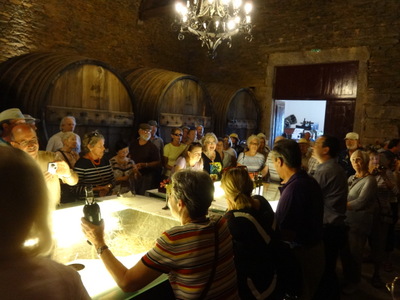
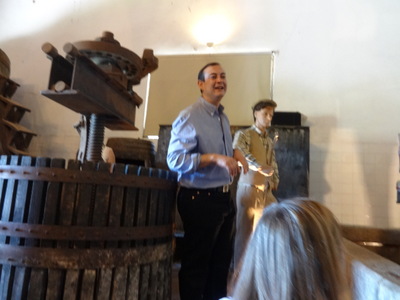 After the obligatory exit through the gift shop, we reboarded the buses for the trip to Quinta da Avessada, where we had lunch. "Quinta" literally means "fifth" and was originally a term for a parcel of land (like "the back forty"), but now it forms a part of almost all winery names.
After the obligatory exit through the gift shop, we reboarded the buses for the trip to Quinta da Avessada, where we had lunch. "Quinta" literally means "fifth" and was originally a term for a parcel of land (like "the back forty"), but now it forms a part of almost all winery names.
Every leg of our bus transport was incredibly scenic, whether from the ship to Favaios, from there to lunch, or from lunch back to the ship. First thing in the morning, we started by driving past the lock the ship was about to pass through, about 18 m drop, on its way to meet us later in the day. We were told that a famous wine called Barca Velha (old boat) comes from this area. It isn't produced every year, but only in the best years. It may be produced this year.
At another point, we could see a strange, elongated, angular white building on the opposite bank of the river, snaking its way down the hillside. Our guide identified it as the nbew high-performance rowing center, where Portuguese rowers train for international competition. Rowers from other countries also come to use it.
At other points in the course of the day, we enjoyed a iew of an almost-finished hydroelectric dam on a tributary that will supply electricity for 300,000 people, a little more than the population of central Porto (3% of their income will go to the environmental compensation fund), a gorgeous six-star hotel ("Treixas" something?) with a dovecote and vines, a guy out hoeing his cabbages and other nearby plowing with a mule, signs marking small villages and towns and carrying large images of apples or grapes, according to the local product.
The vegetation changed constantly as we rose and fell in altitude and moved farther from or closer to the river—pines, juniper, chapparal. A few fields of corn, apple orchards. Big stone outcrops. A few very small groups of black cattle.
Our guide also filled us in on the local terms for ordering mixed drinks: A "turbo" is beer and coke; "diesel" is beer and muscatel; beer and 7-up is "panaché" (as in France); "receta" is beer, either red or white wine, and sugar. Just in case you needed to know . . .
At Quinta da Avessada, we were met as we descended from the bus by a three-man musical ensemble, who reappeared later, after our tour, to play for us during lunch. First, though, we were ushered into the room shown at the left, lined with wine barrels, for a tasting and description of the winery's history and current functioning.
Our host there, the proprietor, was a wild and crazy guy. He reminded us all at different moments of Mr. Bean, Rowan Atkinson as Medieval Blackadder in a cheerful mood, and Peewee Herman. His manner was dramatic to the point of hysteria, and his favorite catchphrase was "Oh, my gods!!!" By his own admission, he was having the time of his life; he loves hosting tourists. He was actually pretty hard to photograph, because the light was dim, and he was in constant motion. That's him in the blue shirt in the right-hand photo (the figure behind him is a mannekin performing some wine-making task). He's in the left-hand photo, too, third person to the right of the lady holding the wine bottle.
Our host (he's the one who claims the temperature of the feet was important to warming the grapes to fermentation temperature) claimed that they have wine from his father's and his grandfather's time, 50 and 75 years old. Once a year, they taste and top up with the preceding vintage and a little wine spirit, to replace "la part des anges" (the portion that evaporates through the barrel in the course of a year). The oldest is up to 24% alcohol by now. In smaller barrels, they have some that's almost 120 years old. The tasting and topping up is done on the occasion of the priest's annual visit to bless the winery; he drinks a glass of the oldest, then (according to our host) scatters holy water everywhere. Each year, they bottle four bottles, two of which are auctioned for charity.
I think he said one of the wines served at lunch was made at 200 m altitude by his brother.
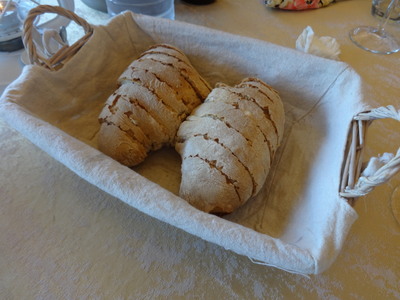
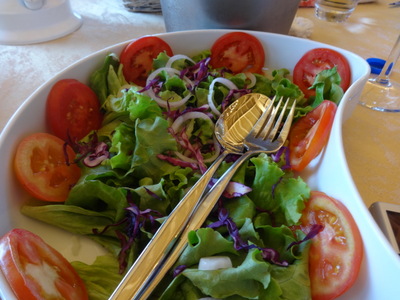 We began with four-corner bread, shown here sliced but presented so as to show its original shape.
We began with four-corner bread, shown here sliced but presented so as to show its original shape.
Then came salad and a starter of blood and regular sausage (both excellent), fried pork chunks (some very fatty), and battered cod cakes.
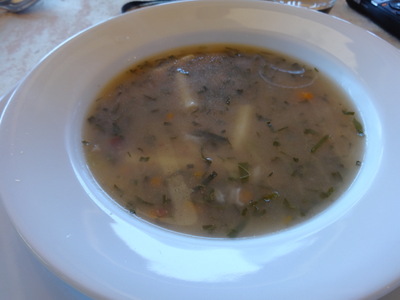
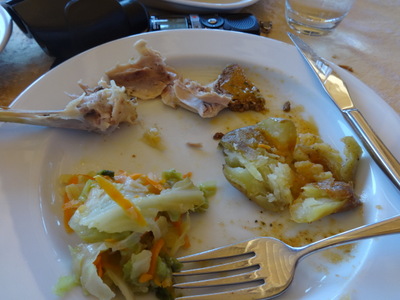 The next course was a soup made of "everything phylloxera doesn't eat" (veggies, cabbage, beans, rice, etc.), modeled on that provided by Ferreinha during the phylloxera famine.
The next course was a soup made of "everything phylloxera doesn't eat" (veggies, cabbage, beans, rice, etc.), modeled on that provided by Ferreinha during the phylloxera famine.
The main course and its accompaniments were served by guys who came around with big platters and spooned as much as you wanted onto your plate. My plate (in the right-hand photo) has a stewed chicken leg (mostly dismantled), a potato crushed and topped with juice from the chicken, and a heap of a typically Portuguese vegetable mixture featuring cabbage, carrots, and onion but including small amounts of lots of other vegetables.
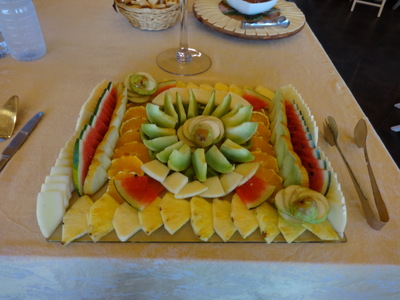
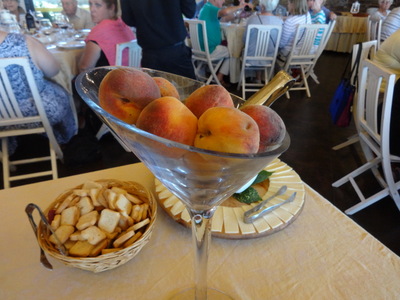 Dessert was a buffet and was gorgeous.
Dessert was a buffet and was gorgeous.
I provide only a few photos, but the variety was quite large, running to cakes, tarts, and flans in addition to this beautiful fruit assortment (watermelon, white melon, apple, pear, pineapple, and oranges) and giant martini glass full of small, dead ripe, and very sweet peaches.
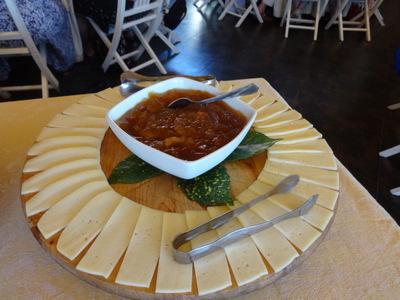
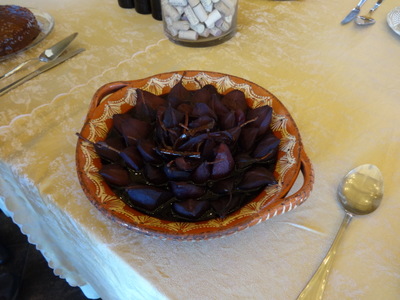 At the left here is a platter of sliced Manchego cheese, with a bowl of jam (melon, I think) to accompany it. It's accompanying basket of little toasts is visible in the photo of the peaches.
At the left here is a platter of sliced Manchego cheese, with a bowl of jam (melon, I think) to accompany it. It's accompanying basket of little toasts is visible in the photo of the peaches.
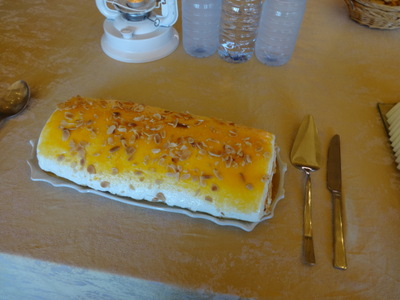
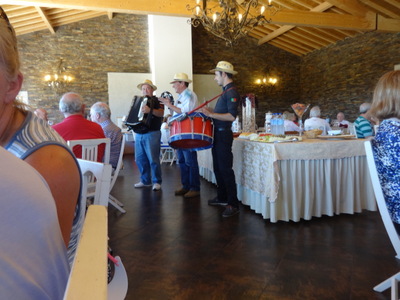 We almost passed up this orange and white item, because it looked so much like the previous day's dreadful torta de San Marcos, but someone tried a little and said, "Wow." It was a sort of jelly roll of soft meringue with an apricot (or peach?) glaze over the top and filled with a delicious cinnamon-flavored filling, like a soft cinnamon pavlova; great!
We almost passed up this orange and white item, because it looked so much like the previous day's dreadful torta de San Marcos, but someone tried a little and said, "Wow." It was a sort of jelly roll of soft meringue with an apricot (or peach?) glaze over the top and filled with a delicious cinnamon-flavored filling, like a soft cinnamon pavlova; great!
Meanwhile, the band came back and played through dessert on accordion, drum, and tambourine.
Afterward, we were invited to step out onto the terrace to admire the spectacular views of the valley from this hilltop location before we boarded the bus back to the ship, which we would meet in Pinhão. Last thing before each bus pulled out, our host stepped aboard to shout "Oh, my gods!!!" one more time and to beg us to come back again and to stay longer.
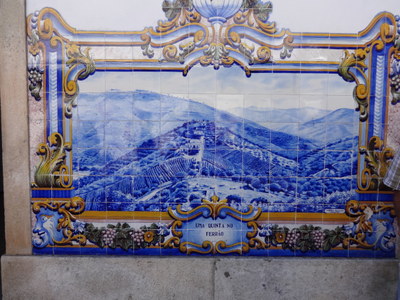
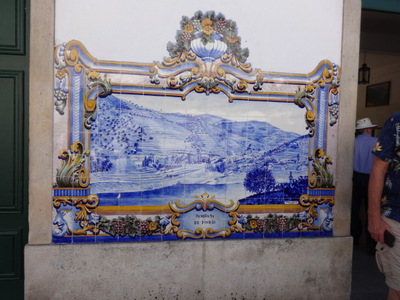 The town of Pinhão is a tourist destination in its own right, which we had neglected almost completely, so before going back aboard, we braved the afternoon heat long enough to stroll as far as the train station, which is famous for its tile decoration.
The town of Pinhão is a tourist destination in its own right, which we had neglected almost completely, so before going back aboard, we braved the afternoon heat long enough to stroll as far as the train station, which is famous for its tile decoration.
The scene at the left is entitled "uma quinta no ferrão"; that at the right is "panorama de Pinhão."
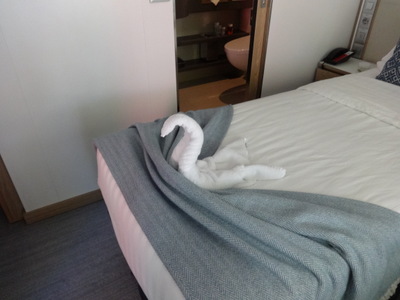
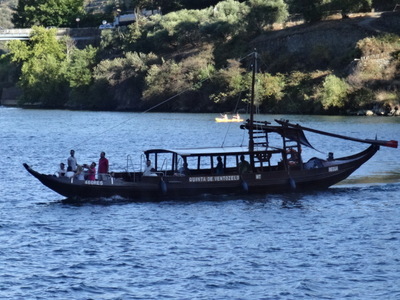 A disadvantage of being ecologically minded and not having our towels and linens changed every day is that we never saw the full range of decorative towel folds used by the crew. I did particularly like this one, though.
A disadvantage of being ecologically minded and not having our towels and linens changed every day is that we never saw the full range of decorative towel folds used by the crew. I did particularly like this one, though.
The right-hand photo shows an old-fashioned river boat that cruised by as we changed for dinner. According to the lettering on its sides, it's from Quinta de Ventozelo.
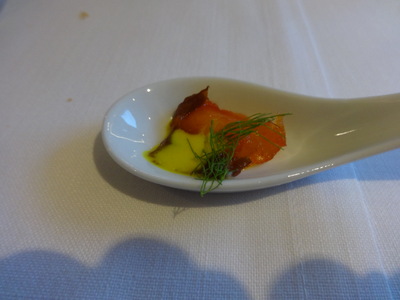
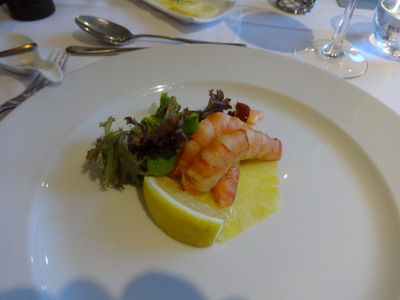 Alas, I appear to have neglected my duty, as I have no photo of the evening's "farewell dinner" menu and must fall back on photos.
Alas, I appear to have neglected my duty, as I have no photo of the evening's "farewell dinner" menu and must fall back on photos.
The amuse-bouche, served in an Asian-style ceramic spoon, was a litle piece of smoked salmon garnished with dill and a creamy yellow saffron sauce.
My first course was cold prawns served atop a lemon sauce with a little fluff of salad on the side.
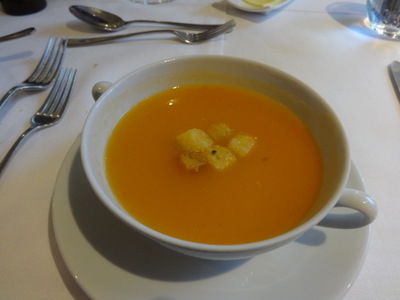
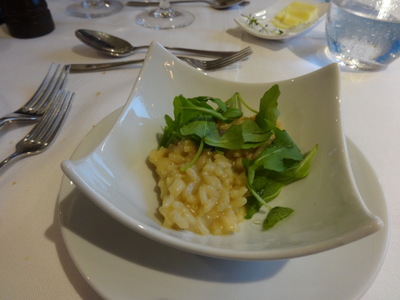 Then came soup with small croutons (it was probably carrot, judging from the color, as the chef was proud that none of his soups contained any butter or cream, so it couldn't be cream of tomato).
Then came soup with small croutons (it was probably carrot, judging from the color, as the chef was proud that none of his soups contained any butter or cream, so it couldn't be cream of tomato).
David started with a creamy saffron risotto with baby arugula on top.
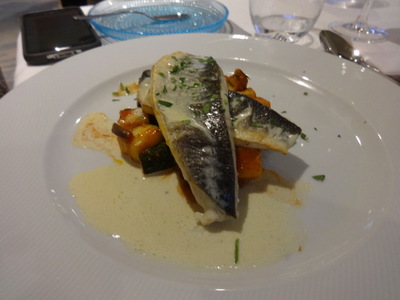
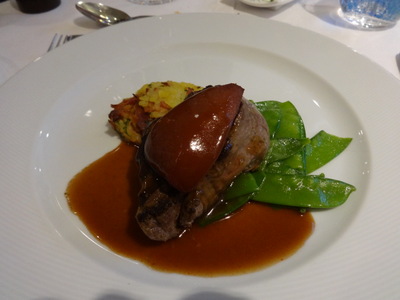 My main course was grilled fish over roasted vegetables.
My main course was grilled fish over roasted vegetables.
David's was a steak, probably pork, as it's topped with a poached pear, which would be odd with beef.
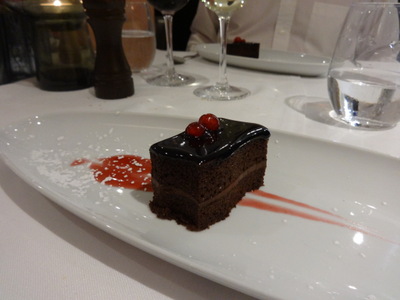
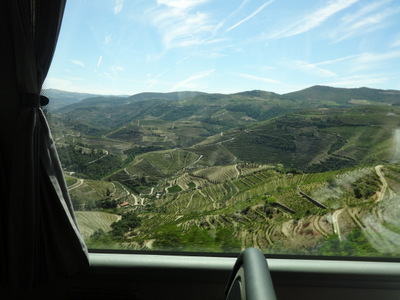 The only dessert I got a photo of was this handsome chocolate layer cake topped with fresh currants.
The only dessert I got a photo of was this handsome chocolate layer cake topped with fresh currants.
Finally, here's a view from the bus. All day long, we drove by views like this. The whole area is incredibly picturesque.
As I mentioned above, this was billed as the "farewell dinner," but it was not, in fact, the last dinner of the cruise. Viking has discovered that life is much less hectic for passengers and crew alike if they do the big farewell a night early, leaving everyone the time and relaxed atmosphere on the final night to pack for disembarcation in the morning.
The predinner briefing was accordingly a little longer, as we learned not only the details of the following day's excursions but all we needed to know about making plans for the next stages of our respective journeys. Some passengers would be boarding a Viking bus for a two-day "cruise extension" to Santiago da Compostela. Others would need taxis to the airport at various times or to hotels in Porto. The four of us would need a taxi to the station for the short train ride to Aveiro, where the Deep Sea Meetings would take place.
We were supplied with a list of recommended taxi departure times by flight time so that everyone woul dknow when they should leave for the airport. We'll get a cab booked for 9:30 a.m. to catch the 10:05 a.m. to Aveiro.
In the course of the evening and next morning, Viking staff consulted each of us about what plans were needed, and We were issued new paper tags for our baggage, color coded according to immediate destination after disembarkation. We got black tags, meaning "no flight, taxi needed." These people are really organized!
We were also issued feedback forms and tip envelopes. One envelope was for the cruise director, another for the senior staff, and a third for a tip to be divided among the other staff members (kitchen crew, wait and bar staff, chambermaids, engine crew, guides, and bus drivers)—36 people in all—though I'm told that on some Viking cruises, the system works differently. Recommendations were also offered as to the amount to be included in the latter envelope.
Dinner was followed by a "70s and 80s music night" in the lounge.